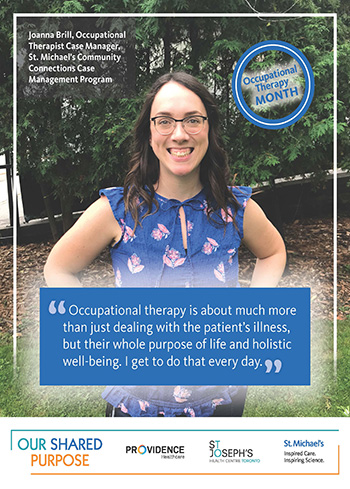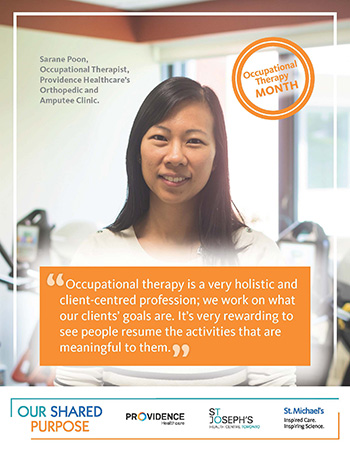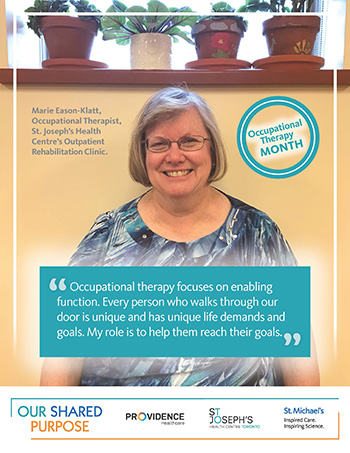All about the holistic work of occupational therapists

By Selma Al-Samarrai
It can be helping people to get back to bathing, making meals, or exercising.
October is Occupational Therapy month and we interviewed three occupational therapists across the
network who work with very different patient groups to highlight the diversity of their roles and the
impact of their work on their patients.
The “occupation” in occupational therapy refers to anything one does to occupy their time.
Occupational therapists work with individuals whose ability to perform some day-to-day activities is
impacted by illness or injury. These activities are divided into three general categories:
- Self-care: bathing, eating meals, taking medications
- Productivity: buying groceries, making meals, going to school or work
- Leisure: traveling, reading, exercising, listening to music

Joanna Brill, occupational therapist case manager, St. Michael’s Community Connections Case Management Program
Joanna Brill: An occupational therapist case manager in the St. Michael’s Community Connections Case
Management Program, which is one of the hospital’s mental health and addictions community outreach
services.
What patient population do you work with?
I work with adults who have experienced mental illness and need more support to live independently in
the community.
Many of the individuals I work with have schizophrenia and the symptoms of their illness, which often
includes psychosis, are impacting their ability to perform daily tasks.
Most of them are newly discharged from psychiatric hospitalizations at St. Michael’s and are flagged for
me as patients who require follow-up. I contact them and then meet them wherever they are most
comfortable doing so: their home, in their community, or here at the Sherbourne Clinic.
What does your role entail?
Occupational therapy is very specific to the person.
One example of the type of work I’ve done with my clients is to support those whose symptoms include
hearing voices. My clients may find these voices distressing and as a result may have difficulty working
or even leaving the house. Other clients may find this symptom distracting, which would impact their
ability to focus on a task like making a meal or remembering to take medication.
That’s where I come in: I can support each individual to cope with the distracting and distressing
experiences in order to be able to accomplish the tasks that are important to them. I provide a lot
ofsupport which includes building on the individual’s strengths and encouraging the use of positive
coping strategies to get them to take medication as prescribed, get enough sleep, and follow up with
their appointments.
There are already so many barriers for the people I work with to access the services they need so once
they work with me, I work to remove as many barriers as possible for them to access my team’s
services.
Why did you choose occupational therapy as your career?
I wanted to have a career supporting not just someone’s health but also their holistic well-being.
Occupational therapy is about much more than just dealing with the patient’s illness, but their whole
purpose of life and holistic well-being. I get to do that every day.

Sarane Poon, occupational therapist in Providence Healthcare’s Orthopedic and Amputee Clinic
Sarane Poon: An occupational therapist in the Orthopedic and Amputee Clinic at Providence Healthcare.
What patient population do you work with?
I serve adults who have recently experienced lower extremity amputation, or an orthopaedic injury such
as a hip fracture or knee replacement.
What does your role entail?
We’re a very holistic profession, so we look at not just physical needs but also cognitive needs, and how
we can improve our patient’s abilities and/or modify their environment to make it easier for them to
perform certain tasks.
For example, if a patient wants to travel following an injury, my role is to advise them on what they need
to discuss with the airline and consider before they travel: how will they be able to use the bathroom on
the plane, what amenities will be ready for them at their destination, and what kind of equipment
would they need. I sometimes also simulate the task with input from the patient to address how to
manage the task as safely as possible.
Another example is for clients with poor balance or back pain, we teach proper body mechanics, re-train
balance, and may ask them to move items that are frequently used in the kitchen to counter height or
above to avoid bending. For those with newly reduced mobility, we recommend adaptive equipment in
the bathroom such as grab bars and raised toilet seats to improve safety.
Why did you choose occupational therapy as your career?
It’s very rewarding to see people get back to doing the activities that are meaningful to them, and to
help them come up with strategies on how to do things differently and still be able to enjoy what they
used to do. It gives them such quality of life. I love that it’s a very holistic and client-centred profession;
we work on what their goals are.

Marie Eason-Klatt, occupational therapist, St. Joseph’s Health
Centre’s Outpatient Rehabilitation Clinic
Marie Eason-Klatt: An occupational therapist who specializes in hand therapy at St. Joseph’s Health
Centre’s Outpatient Rehabilitation Clinic.
What patient population do you work with?
I see patients of all ages who have sustained injuries to their hands or who have conditions and diseases
that impact their ability to use their hands for functional activities. I work with a broad range of age
groups from infants with congenital hand abnormalities to elderly patients with fractures in their hands.
However, the majority of patients that I work with are adults of a working age who are referred to me
following a trauma to their hands or upper limbs. My practice directly supports the Plastic Surgery and
Orthopaedic Surgery services at St. Joseph’s.
What does your role entail?
Following a hand injury, I often need to fabricate a custom orthosis or splint for a patient to allow some
hand function during the period of fracture healing. I use both hand exercises and activities throughout
their rehabilitation to improve their movement and function. Treatment may consist of grasping light
objects to enable feeding using their affected hand or working with dressing boards to assist them with
returning to dressing independently.
Since most of the patients I see are of working age, their main goal is to resume their occupational role
following a hand injury. We discuss the physical demands of their job and I monitor their range of
motion, grip strength and pinch strength throughout their rehabilitation, and I design a treatment
program where they practice using various pieces of equipment that they will be using at work. This
may include wrenches, screw drivers, keyboards, and computer mice.
As for leisure activities, an example of work I’ve done with my patients is providing an anti-vibration
glove for them to be able to return to golfing following a nerve injury.
The scope of occupational therapy is very broad, because the scope of people’s lives is very broad.
Why did you choose occupational therapy as your career?
I chose occupational therapy originally because I knew the profession was diverse enough to hold my
interest, and I was right!
My area of work is also very closely and uniquely tied to surgical developments. The majority of my
patients come in to see me after they’ve received orthopaedic or plastic surgery on their hands. With
advancements in surgery and research, and with development of new thermoplastics I use to fabricate
custom orthoses, my practice has really evolved.
Every person who walks through our door is unique and has unique life demands. My role is to help
them reach their goals.
About St. Michael’s Hospital
St. Michael’s Hospital provides compassionate care to all who enter its doors. The hospital also provides outstanding medical education to future health care professionals in more than 29 academic disciplines. Critical care and trauma, heart disease, neurosurgery, diabetes, cancer care, care of the homeless and global health are among the Hospital’s recognized areas of expertise. Through the Keenan Research Centre and the Li Ka Shing International Healthcare Education Centre, which make up the Li Ka Shing Knowledge Institute, research and education at St. Michael’s Hospital are recognized and make an impact around the world. Founded in 1892, the hospital is fully affiliated with the University of Toronto.
St. Michael’s Hospital with Providence Healthcare and St. Joseph’s Health Centre now operate under one corporate entity as of August 1, 2017. United, the three organizations serve patients, residents and clients across the full spectrum of care, spanning primary care, secondary community care, tertiary and quaternary care services to post-acute through rehabilitation, palliative care and long-term care, while investing in world-class research and education.
